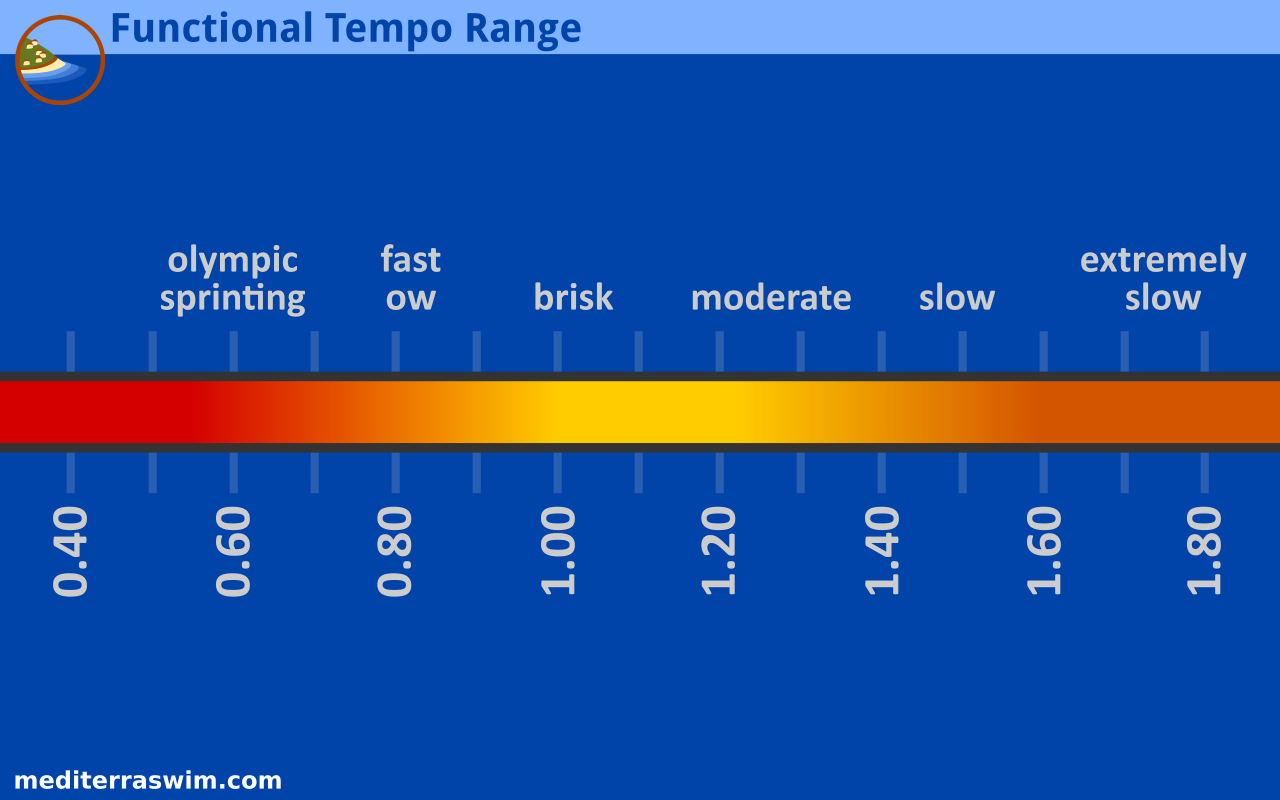Finding Your Current Tempo Range
Every swimmer – trained or not – has a range of tempo he/she can swim with right now, even if it is a very narrow range. That might be a range on the fast side or a range on the slow side of the Functional Tempo Range, but nonetheless each person can move their arms through the stroke cycle at some tempo.
Your current tempo range might be on the fast side or the slow side of what we universally consider Fast or Slow, but nonetheless each person can move their arms through the stroke cycle at some tempo. Whether that range is suitable for your goal is another question. But don’t worry, your tempo range can be expanded through systematic training.
You may know your current comfortable tempo – a single number in the middle of your comfortable tempo range, but you still need to explore the boundaries on both sides of that middle number.
Finding Your Current Tempo Range
You should play with your Tempo Trainer to find out what tempo range you currently find comfortable.
First, you should have determined what your Comfortable Tempo (TC) is. Please read and follow the instructions in Finding Your Current Comfortable Tempo.
You also need to have some measurement of your current comfortable stroke count range (SPL ‘N’) and your current comfortable tempo TC. For example, you may know you can make it within 19 to 22 strokes per length (SPL) and that you take about 22 strokes per length when swimming faster, and about 19 strokes per length when swimming slower.
Starting in the higher side of your SPL range, you will swim several lengths maintaining that SPL N. Start with your TT set to your tempo TC and swim 2x to 4x 25. If you can easily maintain your SPL at that tempo with precise strokes, then speed up tempo by -0.03 seconds. When it feels a little challenging to hold SPL and precision at a certain tempo then speed up the tempo in smaller increments, like -0.02 or -0.01 and repeat the 2x to 4x 25s. If you’ve already increased tempo by -0.06 seconds or more, and it feels almost too difficult to hold your chosen stroke count N, then you may (just once) add 1 stroke to your SPL (N+1) and try to keep going. When you can just barely hold your SPL N+1 at that tempo, you may consider that your current Fast Tempo Threshold.
You can do that same process in the opposite, slower direction. Start with your TT set to your TC and swim 2x 25. In this direction, you will likely lower your SPL N for a few tempo steps, then it will no longer increase. When either you cannot maintain balance or you cannot lower your SPL further (without more effort or strain), you may consider this to be your current Slow Tempo Threshold.
A swimmer might work through a series of repeats working toward her Fast Tempo Threshold, like this…
- Start at 1.45 and SPL is easily at 21
- Change by -0.03 = 1.42 and SPL is at 21 easily
- Change by -0.03 = 1.39 and SPL is at 21 is OK
- Change by -0.03 = 1.36 and SPL is not stable at 21-22
- Allow N+1, change by -0.03 = 1.33 and SPL is at 22 OK
- Change by -0.03 = 1.30 and SPL is at 22, but very shaky
- Change by -0.02 =1.28 and SPL goes up to 23
- Change by -0.01 =1.27 and SPL is at 23 or 24, 22 is impossible
- Change by +0.02 = 1.29 and SPL is at 23
- Change by +0.01 = 1.30 and SPL is at 22, but requires all concentration
She swims another 2x 25 at 1.30 barely holding SPL 22 and confirms this is her current Fast Tempo Threshold.

